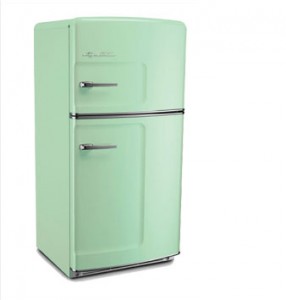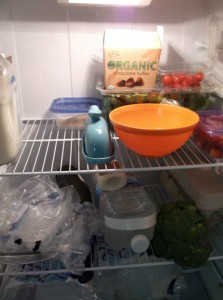Looking for a fun way to spend the hottest week of the summer thus far?
I’m just going to go out on a limb here and say that spending it without a working refrigerator is NOT it.
Last Wednesday I was out for the day. I got home and opened the fridge and grabbed a drink. I though, “Hmm….that isn’t very cold.”
And indeed it was not, because my refrigerator had stopped working properly sometime earlier that day. Because of the 4th of July weekend, I wasn’t able to get anyone to come and repair it until Monday. Then, after it was diagnosed, a part had to be ordered which will not arrive until tomorrow. So there you have it…a solid week in 90+ weather with no fridge.
In a power outage situation, this is not an unlikely scenario at all. So in the spirit of making this a “chance-to-practice-preps” experience instead of a “dad-gum-it- I-had-to-throw-out-a-bunch-of-groceries” experience, here’s what I learned.
Food safety rules
I was absolutely loathe to throw away groceries, but after having a recent bout of food poisoning after a dinner out, I wasn’t will to take any chances. The dog thoroughly enjoyed her bowl of roast beef with potatoes and carrots though.
FoodSafety.gov offers these guidelines:
Is food in the refrigerator safe during a power outage? It should be safe as long as power is out no more than 4 hours. Keep the door closed as much as possible. Discard any perishable food (such as meat, poultry, fish, eggs, and leftovers) that have been above 40 °F for over 2 hours.
Never taste food to determine its safety! You can’t rely on appearance or odor to determine whether food is safe.
Note: Always discard any items in the refrigerator that have come into contact with raw meat juices.
You will have to evaluate each item separately. Use this chart as a guide.
Food Categories Specific Foods Held above 40 °F for over 2 hours MEAT, POULTRY, SEAFOOD Raw or leftover cooked meat, poultry, fish, or seafood; soy meat substitutes Discard Thawing meat or poultry Discard Salads: Meat, tuna, shrimp, chicken, or egg salad Discard Gravy, stuffing, broth Discard Lunchmeats, hot dogs, bacon, sausage, dried beef Discard Pizza – with any topping Discard Canned hams labeled “Keep Refrigerated” Discard Canned meats and fish, opened Discard Casseroles, soups, stews Discard CHEESE Soft Cheeses: blue/bleu, Roquefort, Brie, Camembert, cottage, cream, Edam, Monterey Jack, ricotta, mozzarella, Muenster, Neufchatel, queso blanco, queso fresco Discard Hard Cheeses: Cheddar, Colby, Swiss, Parmesan, provolone, Romano Safe Processed Cheeses Safe Shredded Cheeses Discard Low-fat Cheeses Discard Grated Parmesan, Romano, or combination (in can or jar) Safe DAIRY Milk, cream, sour cream, buttermilk, evaporated milk, yogurt, eggnog, soy milk Discard Butter, margarine Safe Baby formula, opened Discard EGGS Fresh eggs, hard-cooked in shell, egg dishes, egg products Discard Custards and puddings, quiche Discard FRUITS Fresh fruits, cut Discard Fruit juices, opened Safe Canned fruits, opened Safe Fresh fruits, coconut, raisins, dried fruits, candied fruits, dates Safe SAUCES, SPREADS, JAMS Opened mayonnaise, tartar sauce, horseradish Discard if above 50 °F for over 8 hrs. Peanut butter Safe Jelly, relish, taco sauce, mustard, catsup, olives, pickles Safe Worcestershire, soy, barbecue, hoisin sauces Safe Fish sauces, oyster sauce Discard Opened vinegar-based dressings Safe Opened creamy-based dressings Discard Spaghetti sauce, opened jar Discard BREAD, CAKES, COOKIES, PASTA, GRAINS Bread, rolls, cakes, muffins, quick breads, tortillas Safe Refrigerator biscuits, rolls, cookie dough Discard Cooked pasta, rice, potatoes Discard Pasta salads with mayonnaise or vinaigrette Discard Fresh pasta Discard Cheesecake Discard Breakfast foods –waffles, pancakes, bagels Safe PIES, PASTRY Pastries, cream filled Discard Pies – custard, cheese filled, or chiffon; quiche Discard Pies, fruit Safe VEGETABLES Fresh mushrooms, herbs, spices Safe Greens, pre-cut, pre-washed, packaged Discard Vegetables, raw Safe Vegetables, cooked; tofu Discard Vegetable juice, opened Discard Baked potatoes Discard Commercial garlic in oil Discard Potato salad Discard Casseroles, soups, stews Discard
The one guideline I felt comfortable not following was the eggs. Mine came straight from the chicken that day, and since they could have been sitting under a hen for another 10-12 hours, I was willing to take the risk. The rest of the items had to go, unfortunately.
Damage control
Had I been home and realized there was a problem in time, I would have immediately canned, cooked, or otherwise preserved the food in my refrigerator. Click HERE to learn how to can your own recipes.
Since this is not an area-wide power outage, I have access to ice. The freezer works somewhat so I am able to make more ice. I’m keeping delicate items in the freezer, like milk, mayonaisse, and meat. (I have been buying about 2 days’ worth of fresh items at a time for the past week.)
Basically, a refrigerator that doesn’t work can be used like a large, standing cooler. If you keep replenishing the ice, you can keep things at a moderate temperature. Here is a picture of my fridge. You can see the large blocks of ice on the sturdy bottom shelf, and bowls of ice on the other two shelves.
Unfortunately, it still isn’t that cold, so I’m using it for drinks, butter, veggies, fruit, hard cheese, and my beloved chocolate.
Here’s the ambient temperature in the fridge after having the door open for a moment to get this photo. This is with all of the ice in it.
Power outages
In a grid-down situation, things would be different. I am able to use my freezer sort of like a cranky refrigerator as long as I don’t mind things potentially getting partially frozen. As well, I have easy access to ice as near as the closest gas station.
For keeping your food safe during a power outage, take these steps to be prepared:
- Use your deep freezer to freeze gallon bottles of water (leave space for expansion). You can use these to keep the contents of your refrigerator cool.
- Have a cooking method that does not require grid power in case you need to can your perishable food.
- Print out the food safety guidelines above and keep them near the fridge. If you have no grid, you won’t be able to access the list on the internet.
- If you don’t already have one, invest in a thermometer for your refrigerator so that you can monitor the temperature.
- Store food in ways that are not grid-dependent: dehydrate or can when possible.
- Learn how to make a clay pot refrigerator (and get all of your supplies)
When in doubt, throw it out. Food poisoning is horrible, and can even be deadly. It’s just not worth it.
In a long-term scenario, it would be an entirely different ballgame. We’d begin to rely on the methods our ancestors used: we would cook only amounts that could be immediately consumed or items that did not require refrigeration of the leftovers. As well, we’d eat more fruits and vegetables in hot weather. Learn more about surviving in a long-term off-grid scenario HERE.
As for me, a part has been ordered and I should have a working refrigerator by tomorrow afternoon. It has been a little extra work, what with shuffling ice back and forth between the fridge and freezer, but, in the grand scheme of things, this has only been a blip on the radar, aside from the loss of some food. However, I’m definitely going to freeze some jugs of ice as soon as things are working again!




I’ve really tried to think this through over the last couple of years. In fact, I built a “clay pot refrigerator” (aka: pot in pot, or Zeer pot). It worked best when the humidity was low and I never could get it much below 60 degrees F. That’s actually pretty good when it’s 90 degrees outside. I suppose if evaporative coolers are or were commonly used in your area then a Zeer pot might work to keep essential items, like medicines, cool.
To be honest, I’m looking at “solar coolers” which appear to be a practical alternative. They may be a little pricey but will probably do the trick in a long term power outage. I have no association whatsoever with this example of a solar cooler but it’s offered a potential option http://www.showroom411.com/SiteBrowser.aspx?url=http%3a%2f%2fwww.solarcooltech.com%2fsolar.html. I hope someone out there has tried one of these out and can provide us with a recommendation.
I rarely comment but now I have to.
Your FDA is a bunch of idiots! But probably not more than whatever similar we have in Europe. Some of those guidelines are “tea-cup generation ready”.
To be on the safe side and to cover their a** they can recommend to throw anything after 1 second being out of the fridge. But in my life I ate many things that stood on the open for hours or days and nothing ever happened.
Eggs is a good example as cooked are a great way of having some nutrients in a long journey when you cannot cook. Raw eggs come from chicken butt, lay in the field for hours and days and are perfectly edible.
Cut fruits? Coked pastas? Rice, Potatoes? I’ll happy eat them if they stayed for a day in covered pot in the room temperature.